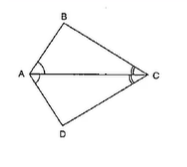If the diagonal of a quadrilateral bisects both and , show that .
To solve the problem, we will use the concept of the Angle Bisector Theorem, which states that if a point lies on the angle bisector of an angle, then the ratio of the lengths of the two segments created by the angle bisector on the opposite side is equal to the ratio of the lengths of the other two sides of the triangle.
1. Identify the Quadrilateral and Diagonal:
We have a quadrilateral ABCD where diagonal BD bisects angles ∠B and ∠D.
2. Construct the Intersection Point:
Let O be the point where diagonals AC and BD intersect.
3. Apply the Angle Bisector Theorem in Triangle ADC:
Since BD bisects ∠D, by the Angle Bisector Theorem:
ADDC=AOOC(Equation 1)
4. Apply the Angle Bisector Theorem in Triangle ABC:
Similarly, since BD bisects ∠B:
ABBC=AOOC(Equation 2)
5. Equate the Right-Hand Sides of Both Equations:
From Equation 1 and Equation 2, we have:
ADDC=ABBC
6. Rearranging the Equation:
This can be rearranged to show that:
ABBC=ADDC
Thus, we have proved that:
ABBC=ADCD
Conclusion:
We have shown that if the diagonal BD of quadrilateral ABCD bisects both angles B and D, then:
ABBC=ADCD
We have a quadrilateral ABCD where diagonal BD bisects angles ∠B and ∠D.
Let O be the point where diagonals AC and BD intersect.
Since BD bisects ∠D, by the Angle Bisector Theorem:
ADDC=AOOC(Equation 1)
Similarly, since BD bisects ∠B:
ABBC=AOOC(Equation 2)
From Equation 1 and Equation 2, we have:
ADDC=ABBC
This can be rearranged to show that:
ABBC=ADDC
Thus, we have proved that:
ABBC=ADCD
We have shown that if the diagonal BD of quadrilateral ABCD bisects both angles B and D, then:
ABBC=ADCD
Topper's Solved these Questions
Similar Questions
If the diagonal BD of a quadrilateral ABCD bisects both ∠B and ∠D , show that ABBC=ADCD .
View SolutionIn Figure, diagonal AC of a quadrilateral ABCD bisects the angles A and C . Prove that AB=AD and CB=CD
 View Solution
View SolutionDiagonals AC and BD of a quadrilateral ABCD intersect each at P. Show That: ar(APB)×ar(CPD)=ar(APD)×ar(PBC)
View SolutionDiagonals AC and BD of a quadrilateral ABCD intersect at O in such a way that ar (AOD)=ar ( BOC). Prove that ABCD is a trapezium.
View SolutionDiagonals AC and BD of a quadrilateral ABCD intersect at O in such a way that ar(AOD)=ar(BOC) . Prove that ABCD is a trapezium.
View SolutionIn a quadrilateral ABCD , given that ∠A+∠D=90o . Prove that AC2+BD2=AD2+BC2 .
View SolutionDiagonals of a quadrilateral ABCD bisect each other. If ∠A=45∘, then ∠B= 115∘ (b) 120∘ (c) 125∘ (d) 135∘
View SolutionIf the diagonals AC,BD of a quadrilateral ABCD, intersect at O, and seqarate the quadrilateral into four triangles of equal area, show that quadrilateral ABCD is a parallelogram. GIVEN : A quadrilateral ABCD such that its diagonals AC and BD intersect at O and separate it into four parts such that ar(AOB)=ar(BOC)=ar(COD)=ar(AOD) TO PROVE : Quadrilateral ABCD is a parallelogram.
View SolutionThe diagonals of quadrilateral ABCD,ACandBD intersect in O. Prove that if BO=OD, the triangles ABCandADC are equal in area.
View SolutionProve that the diagonals of quadrilateral ABCD,AC and BD intersect in O. Prove that if BO=OD, the triangles ABC and ADC are equal in area.
View Solution
